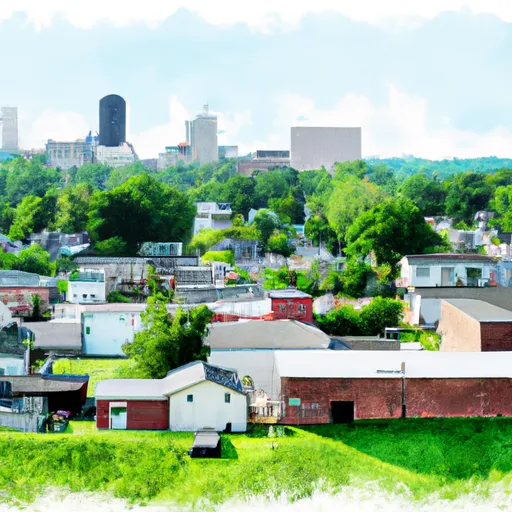-
 Snoflo Premium
Snoflo Premium
Get unlimited access to all our content
With no Ad interruptions! - Start Your Free Trial Login with existing account
Whick
Eden Index
Climate
8.1
•
Recreation
3.4
•
Community
•
Safeguard
4.4/10

Whick, Kentucky is a small rural community located in the southeastern part of the state. The climate in Whick is typically characterized by hot and humid summers, with temperatures often reaching the mid-80s to low 90s Fahrenheit. Winters are generally mild, with average temperatures ranging from the mid-30s to mid-40s Fahrenheit.
Hydrologically, Whick is situated near the South Fork of the Kentucky River, which contributes to the area's water resources. The river and its tributaries provide opportunities for fishing, boating, and other water-based activities. Additionally, Whick is surrounded by lush forests and rolling hills, offering picturesque hiking trails and camping spots for nature enthusiasts.
Outdoor recreation opportunities in Whick are abundant. The nearby Daniel Boone National Forest provides numerous trails for hiking, backpacking, and wildlife observation. The Red River Gorge Geological Area, located within the national forest, offers rock climbing and rappelling opportunities for thrill-seekers. The area is renowned for its stunning natural arches and sandstone cliffs.
In conclusion, Whick, Kentucky offers a diverse climate, with hot summers and mild winters. The community benefits from its proximity to the South Fork of the Kentucky River, providing opportunities for various water activities. The surrounding natural landscapes, including the Daniel Boone National Forest and Red River Gorge, offer ample outdoor recreation opportunities, making Whick an attractive destination for nature lovers and adventure enthusiasts.
What is the Eden Index?
The Snoflo Eden Index serves as a comprehensive rating system for regions, evaluating their desirability through a holistic assessment of climate health, outdoor recreation opportunities, and natural disaster risk, acknowledging the profound impact of these factors on livability and well-being.
Climate Health Indicator (CHI): 8.1
Whick receives approximately
1197mm of rain per year,
with humidity levels near 85%
and air temperatures averaging around
13°C.
Whick has a plant hardyness factor of
6, meaning
plants and agriculture in this region thrive during a short period during spring and early summer. Most
plants will die off during the colder winter months.
By considering the ideal temperature range, reliable water supplies, clean air, and stable seasonal rain or snowpacks, the Climate Health Indicator (CHI) underscores the significance of a healthy climate as the foundation for quality living.
A healthy climate is paramount for ensuring a high quality of life and livability in a region, fostering both physical well-being and environmental harmony. This can be characterized by ideal temperatures, reliable access to water supplies, clean air, and consistent seasonal rain or snowpacks.
Weather Forecast
Streamflow Conditions
Kentucky
Area Rivers
Kentucky
Snowpack Depths
Kentucky
Reservoir Storage Capacity
Kentucky
Groundwater Levels
Recreational Opportunity Index (ROI): 3.4
The Recreational Opportunity Index (ROI) recognizes the value of outdoor recreational options, such as parks, hiking trails, camping sites, and fishing spots, while acknowledging that climate plays a pivotal role in ensuring the comfort and consistency of these experiences.
Access to outdoor recreational opportunities, encompassing activities such as parks, hiking, camping, and fishing, is crucial for overall well-being, and the climate plays a pivotal role in enabling and enhancing these experiences, ensuring that individuals can engage in nature-based activities comfortably and consistently.
Camping Areas
| Campground | Campsites | Reservations | Toilets | Showers | Elevation |
|---|---|---|---|---|---|
| Cosby - Great Smoky Mountains National Park | 165 | 2,430 ft | |||
| Sevier County Park - Douglas Reservoir | None | 1,073 ft | |||
| Cherokee Dam | 42 | 1,132 ft | |||
| Douglas Dam Tailwater | 62 | 1,023 ft | |||
| Smokemont - Smoky Mountains National Park | 142 | 2,242 ft | |||
| Elkmont - Great Smoky Mountains National Park | 220 | 2,177 ft | |||
| Panther Creek State Park | 50 | 1,192 ft | |||
| Douglas Dam Headwater | 65 | 1,037 ft | |||
| Balsam Mountain - Great Smoky Mountains | 43 | 5,328 ft | |||
| Dandridge Municipal Park - Douglas Reservoir | None | 997 ft |
Nearby Ski Areas
Catastrophe Safeguard Index (CSI):
The Catastrophe Safeguard Index (CSI) recognizes that natural disaster risk, encompassing floods, fires, hurricanes, and tornadoes, can drastically affect safety and the overall appeal of an area.
The level of natural disaster risk in a region significantly affects safety and the overall livability, with climate change amplifying these risks by potentially increasing the frequency and intensity of events like floods, fires, hurricanes, and tornadoes, thereby posing substantial challenges to community resilience and well-being.
Community Resilience Indicator (CRI):
The Community Resilience Indicator (CRI) recognizes that education, healthcare, and socioeconomics are crucial to the well-being of a region. The CRI acknowledges the profound impact of these elements on residents' overall quality of life. By evaluating educational resources, healthcare accessibility, and economic inclusivity, the index captures the essential aspects that contribute to a thriving community, fostering resident satisfaction, equity, and social cohesion.

